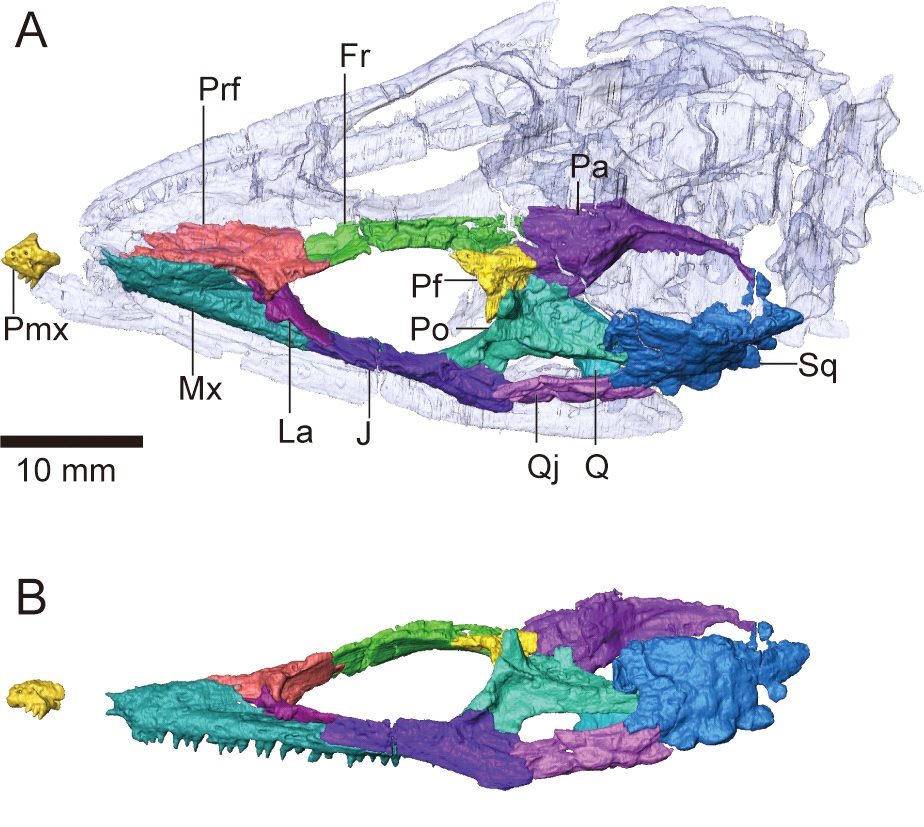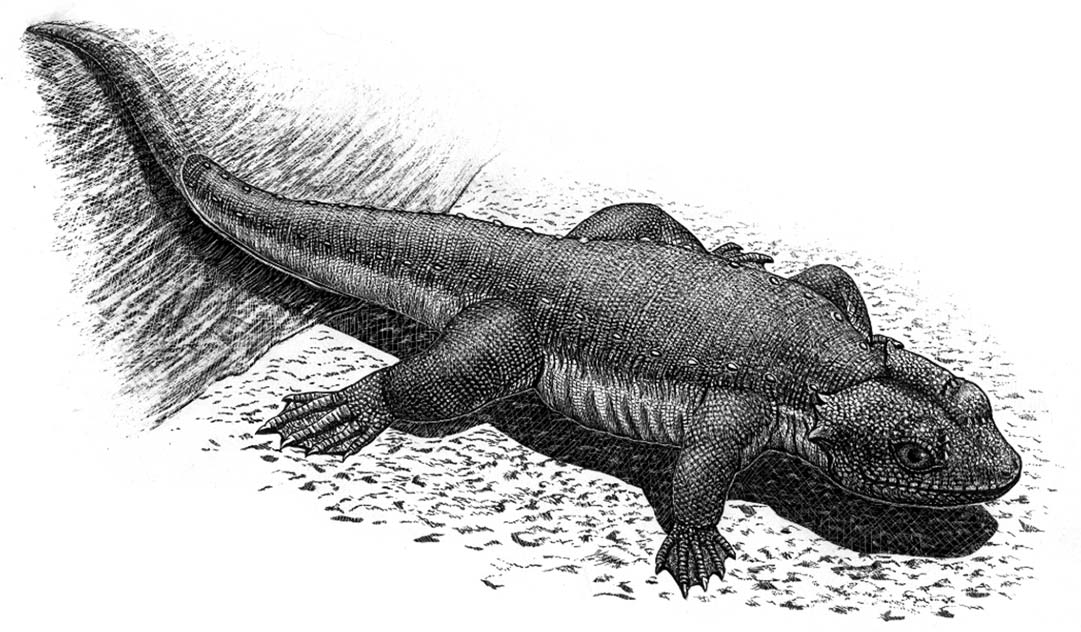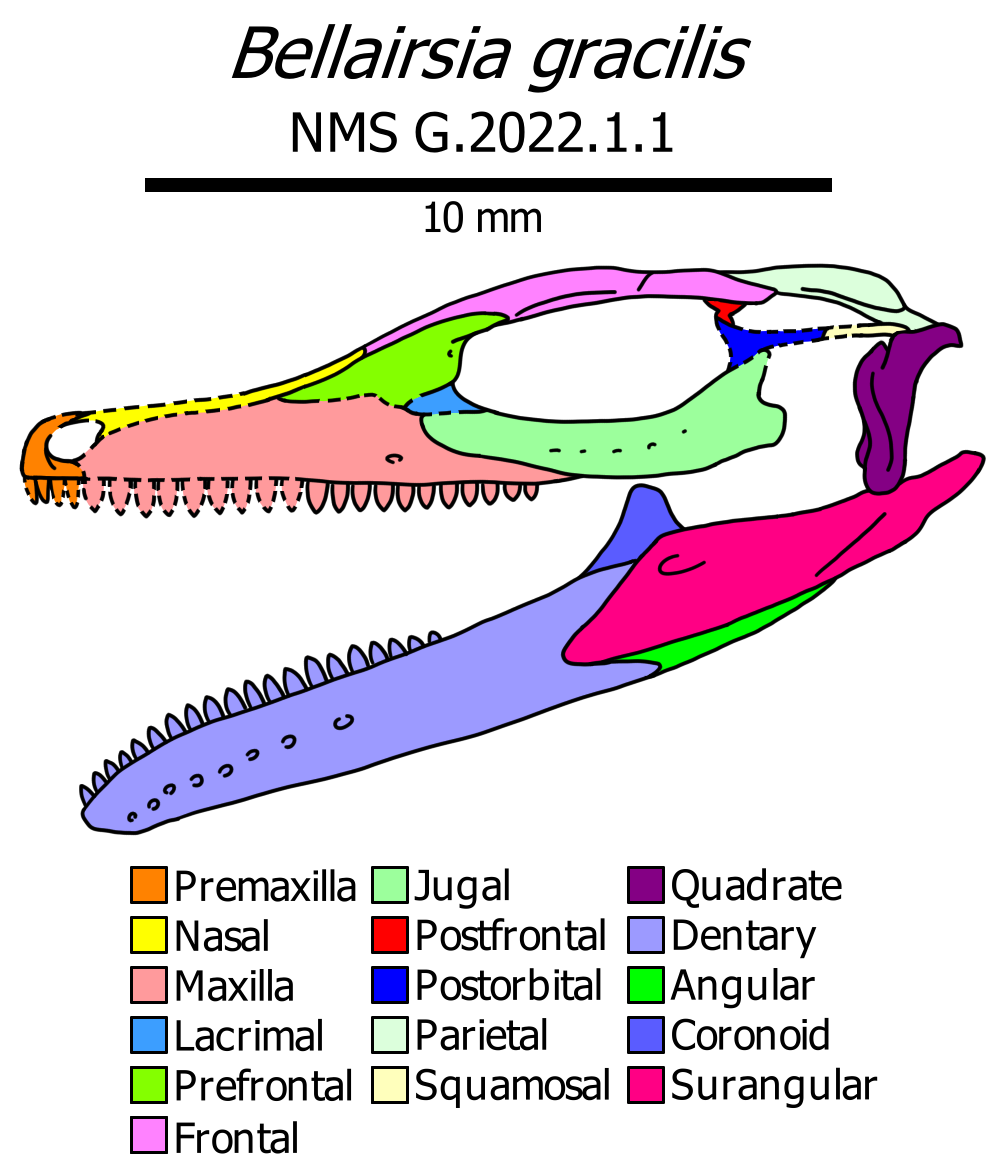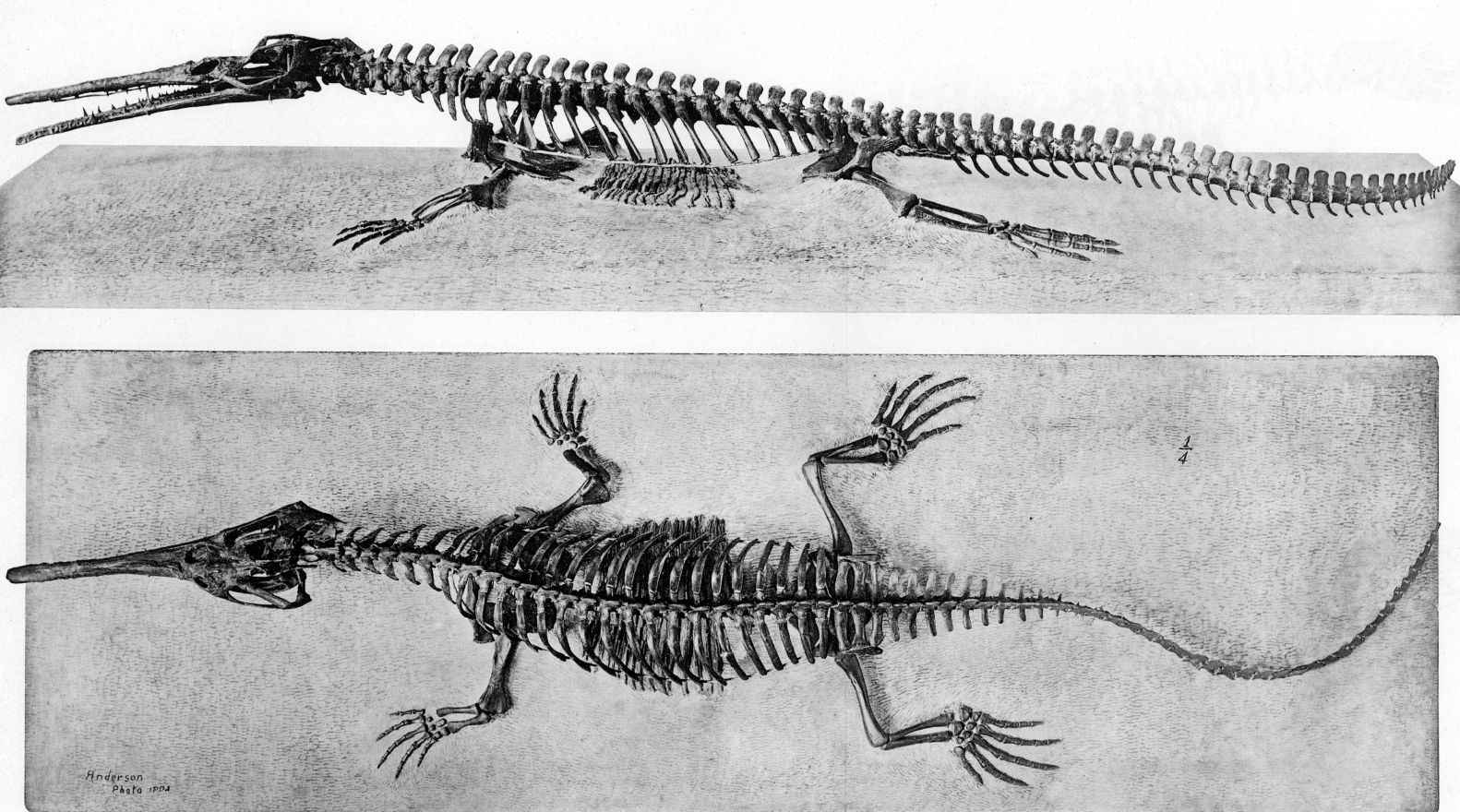|
Cteniogenys
''Cteniogenys'' is a genus of choristodere, a morphologically diverse group of aquatic reptiles. It is part of the monotypic family Cteniogenidae. The type and only named species, ''C. antiquus'', was named in 1928 by Charles W. Gilmore. The holotype, VP.001088, was collected in the Morrison Formation (Como Bluff), Wyoming in 1881 by William H. Reed. More specimens have been discovered since then, including specimens from the Late Jurassic of Portugal and Middle Jurassic of Britain, which have not been assigned to species. Description ''Cteniogenys'' was long, and probably weighed less than . The skull of this genus was long and slender, and the jaws had numerous conical teeth. ''Cteniogenys'' in the Morrison probably fed on insects and small fish. It is mostly known from freshwater sites (rivers and ponds), and is a rare find in the formation (only 60 specimens out of over 2,800 total vertebrate specimens known from the formation), mostly known from northern outcr ... [...More Info...] [...Related Items...] OR: [Wikipedia] [Google] [Baidu] |
Choristodera
Choristodera (from the Greek χωριστός ''chōristos'' + δέρη ''dérē'', 'separated neck') is an extinct order of semiaquatic diapsid reptiles that ranged from the Middle Jurassic, or possibly Triassic, to the late Miocene (168 to 11.6 million years ago). Choristoderes are morphologically diverse, with the best known members being the crocodile-like neochoristoderes such as ''Champsosaurus''. Other choristoderans had lizard-like or long necked morphologies. Choristoderes appear to have been confined to the Northern Hemisphere, having been found in North America, Asia, and Europe, and possibly also North Africa. Choristoderes are generally thought to be derived neodiapsids that are close relatives or members of Sauria. History of Discovery Choristodera was erected in 1876, originally as a suborder of Rhynchocephalia by Edward Drinker Cope to contain ''Champsosaurus,'' which was described from Late Cretaceous strata of Montana by Cope in the same paper. A year later ... [...More Info...] [...Related Items...] OR: [Wikipedia] [Google] [Baidu] |
Coeruleodraco
''Coeruleodraco'' is an extinct genus of choristoderan known from the Late Jurassic ( Oxfordian) Tiaojishan Formation in China. ''Coeruleodraco'' is significant as the most complete Jurassic choristodere taxon, as the only other named Jurassic choristodere '' Cteniogenys'' is based on fragmentary remains. Although similar to '' Philydrosaurus'' in its proportions and postcranial characters, it is distinct in retaining several apparently plesiomorphic characters, including a short snout, paired external nares and an open lower temporal fenestra. Description The skeleton was small, about 20.3 cm (8.0 inches) in length, not including the tail. The tail is incomplete, but including its estimated length, the total length of the skeleton would have been closer to 40.0 cm (15.7 inches). ''Coeruleodraco'' had a generalized, lizard-like body type. This is similar to some early choristoderes (like '' Cteniogenys'', '' Philydrosaurus'', and ''Monjurosuchus''), but contrasts with other c ... [...More Info...] [...Related Items...] OR: [Wikipedia] [Google] [Baidu] |
Como Bluff
Como Bluff is a long ridge extending east–west, located between the towns of Rock River and Medicine Bow, Wyoming. The ridge is an anticline, formed as a result of compressional geological folding. Three geological formations, the Sundance, the Morrison, and the Cloverly Formations, containing fossil remains from the Late Jurassic of the Mesozoic Era are exposed. Nineteenth-century paleontologists discovered many well-preserved specimens of dinosaurs, as well as mammals, turtles, crocodilians, and fish from the Morrison Formation. Because of this, Como Bluff is considered to be one of the major sites for the early discovery of dinosaur remains. Among the species discovered is the only known specimen of '' Coelurus''. Significant discoveries were made in 22 different areas scattered along the entire length of the ridge. It is included on the National Register of Historic Places as well as the National Natural Landmark list. History of discovery The discovery of dinosa ... [...More Info...] [...Related Items...] OR: [Wikipedia] [Google] [Baidu] |
Monjurosuchus
''Monjurosuchus'' is a genus of choristoderan reptile that lived in what is now China and Japan during the Early Cretaceous. It has large eyes, a rounded skull, robust legs with short claws, and a long, thin tail. Fossils have been found that preserve soft tissue, showing that it had soft skin and webbed feet. Description and history ''Monjurosuchus'' was first found in China as part of the Early Cretaceous Jehol Biota. Named in 1940, the type species ''M. splendens'' was the first reptile described from the Yixian Formation. The holotype specimen was lost during World War II but was replaced in 2000 by a recently discovered neotype preserving soft tissue. In 2007, remains were described from the Okurodani Formation of the Tetori Group of Japan. The Japanese material represents a different species of ''Monjurosuchus'' that has not yet been named. ''Monjurosuchus'' was a small choristodere, reaching a length of 40 cm with a 5 cm skull. Unlike related choristoderes, ... [...More Info...] [...Related Items...] OR: [Wikipedia] [Google] [Baidu] |
Kilmaluag Formation
The Kilmaluag Formation is a Middle Jurassic geologic formation in Scotland. It was formerly known as the Ostracod Limestone for the abundance of fossil freshwater ostracods within it. The Kilmaluag Formation is very fossiliferous, with ostracods, gastropods, bivalves, trace fossil burrows, and vertebrate fossil remains. Vertebrate fossils include fish, crocodylomorphs, mammals, small reptiles, amphibians and some large reptile remains including dinosaurs and pterosaurs.Panciroli E, RBJ Benson, S Walsh, RJ Butler, TA Castro, MEH Jones, SE. Evans. 2020Diverse vertebrate assemblage of the Kilmaluag Formation (Bathonian, Middle Jurassic) of Skye, Scotland Earth and Environmental Transactions of the Royal Society of Edinburgh nline1-22 Geology The Kilmaluag Formation is Bathonian, and dates to around 167 million years old. It is part of the Great Estuarine Group of the Hebrides Basin, a series of sediments laid down as the land rose and fell in the area running between what is now ... [...More Info...] [...Related Items...] OR: [Wikipedia] [Google] [Baidu] |
Itat Formation
The Itat Formation ( Russian: итатская свита) is a geologic formation in western Siberia. It was deposited in the Bajocian to Bathonian ages of the Middle Jurassic. Dinosaur remains are among the fossils that have been recovered from the formation, including the proceratosaurid '' Kileskus'', as well as fish, amphibians, mammals and many other vertebrates. The formation is noted for bearing significant coal reserves, with large open pit coal mines extracting lignite from the unit currently in operation. Lithology The lower section of the formation is around 50–130 m thick, and consists of light grey sandstones with gravel, siltstone and rare coal beds. At the Dubinino locality, the 50 m exposed section of the upper part of the formation shows an irregular rhythmic alteration of fine grained sandstone, siltstone and mudstone and coal seams typically a few tens of cm's but up to several meters thick. The deposit is located on the South Eastern margin of the West S ... [...More Info...] [...Related Items...] OR: [Wikipedia] [Google] [Baidu] |
Khurendukhosaurus
''Khurendukhosaurus'' is a genus of choristodere, a type of amphibious reptile. It is known from Lower Cretaceous rocks of Mongolia and Russia. Two species have been named. The type species, ''K. orlovi'', was named in 1984 by Sigogneau–Russell and Efimov for the fragmentary postcranial skeleton PIN 3386/3. This specimen was discovered in the Albian-age Lower Cretaceous Khuren Dukh Formation Formation at Hüren Dukh, central Mongolia. The lake deposits at this site also contain fossils of the choristoderes '' Irenosaurus'' and ''Tchoiria''. Other postcranial bones of ''K. orlovi'' have been found at this site as well. Second species ''K. bajkalensis'' was named by Efimov in 1996 for PIN 2234/201, consisting of a scapulocoracoid and a rib. These bones were found in the Lower Cretaceous Murtoi Formation at Lake Gusinoye, Buryatia, Russia. The first Russian choristodere, Efimov and Storrs (2000) found it difficult to distinguish from ''K. orlovi'' based on the ... [...More Info...] [...Related Items...] OR: [Wikipedia] [Google] [Baidu] |
Balabansai Formation
The Balabansai Formation (sometimes transcribed Balabansay, also known as Balabansai Svita) is a geological formation in Kazakhstan, Kyrgyzstan and Uzbekistan whose strata date back to the Bathonian and Callovian stages of the Middle Jurassic. Dinosaur remains are among the fossils that have been recovered from the formation.Weishampel, David B; et al. (2004). "Dinosaur distribution (Late Jurassic, Asia)." In: Weishampel, David B.; Dodson, Peter; and Osmólska, Halszka (eds.): The Dinosauria, 2nd, Berkeley: University of California Press. Pp. 550–552. . The lithology primarily consists of variegated sandstones, siltstones, claystones, and rare gravels and marls. Many taxa have been found in the formation, including amphibians and mammals Vertebrate paleofauna Indeterminate Avialae remains located in Ongtustik Qazaqstan Oblysy, Kazakhstan. Fish Amphibians Turtles Lizards Choristoderes Crocodyliformes Dinosaurs Pterosaurs Mammals Invertebrat ... [...More Info...] [...Related Items...] OR: [Wikipedia] [Google] [Baidu] |
Alcobaça Formation
The Alcobaça Formation, previously known as the Guimarota Formation and also known as the Consolação Unit, is a geological formation in Portugal. It dates back to the Kimmeridgian stage of the Late Jurassic. It is an important source of information on the diversity of Late Jurassic mammals. Many of the fossils were collected from the now disused and flooded Camadas de Guimarota coal mine. Vertebrate paleofauna Dinosaur eggs are geographically located in Lisbon District, Portugal. Dinosaur tracks are geographically located in Leiria District, Portugal. Amphibians Ornithischians Indeterminate euornithopod remains located in Lisbon District. Indeterminate stegosaurid remains present in Lisbon District. Saurischians Indeterminate sauropod remains located in Leiria and Lisboa."16.1 Distrito do Leiria, Portugal; 3. Camadas de Alcobaça," and "16.4 Distrito do Lisboa, Portugal; 1. Camadas de Alcobaça," in Weishampel, et al. (2004). Pages 548-549. Turtles Lepido ... [...More Info...] [...Related Items...] OR: [Wikipedia] [Google] [Baidu] |
Forest Marble Formation
The Forest Marble is a geological formation in England. Part of the Great Oolite Group, it dates to the late Bathonian stage of the Middle Jurassic.Weishampel, David B; et al. (2004). "Dinosaur distribution (Middle Jurassic, Europe)." In: Weishampel, David B.; Dodson, Peter; and Osmólska, Halszka (eds.): The Dinosauria, 2nd, Berkeley: University of California Press. Pp. 538–541. . Lithology The primary lithology of the formation typically consists of greenish grey variably calcareous silicate mudstone, with lenticular cross bedded limestone units deposited in a marine setting. Dinosaurian fauna Ornithischians Saurischians Microvertebrate fauna Despite the formation being nearly entirely marine, at several localities abundant remains of terrestrial microvertebrates are found, the primary locality being the Kirtlington Mammal Bed (designated 3p) in Kirtlington Quarry near Kirtlington, Oxfordshire. Another important locality is Watton Cliff near Eype in Dorset. ... [...More Info...] [...Related Items...] OR: [Wikipedia] [Google] [Baidu] |
Champsosaurus
''Champsosaurus'' is an extinct genus of crocodile-like choristodere reptile, known from the Late Cretaceous and early Paleogene periods of North America and Europe (Campanian-Paleocene). The name ''Champsosaurus'' is thought to come from , () said in an Ancient Greek source to be an Egyptian word for "crocodiles", and , () Greek for "lizard". The morphology of ''Champsosaurus'' resembles that of gharials, with a long, elongated snout. It was native to freshwater environments where it likely preyed on fish, similar to living gharials. History of research ''Champsosaurus'' was the first member of the Choristodera to be described. ''Champsosaurus'' was named by Edward Drinker Cope in 1876, from isolated vertebrae found in Late Cretaceous strata of the Judith River Formation on the banks of the Judith River in Fergus County, Montana. Cope designated ''C. annectens'' as the type species rather than the first named ''C. profundus'' due to the larger number of vertebrae he attri ... [...More Info...] [...Related Items...] OR: [Wikipedia] [Google] [Baidu] |
Dinosaur Park Formation
The Dinosaur Park Formation is the uppermost member of the Belly River Group (also known as the Judith River Group), a major geologic unit in southern Alberta. It was deposited during the Campanian stage of the Late Cretaceous, between about 76.5 and 74.4 million years ago. It was deposited in alluvial plain, alluvial and coastal plain environments, and it is bounded by the nonmarine Oldman Formation below it and the marine (ocean), marine Bearpaw Formation above it.Eberth, D.A. 2005. The geology. In: Currie, P.J., and Koppelhus, E.B. (eds), Dinosaur Provincial Park: A Spectacular Ancient Ecosystem Revealed. Indiana University Press: Bloomington and Indianapolis, p.54-82. . The Dinosaur Park Formation contains dense concentrations of dinosaur skeletons, both articulated and disarticulated, which are often found with preserved remains of soft tissues. Remains of other animals such as fish, turtles, and crocodilians, as well as plant remains, are also abundant. The formation h ... [...More Info...] [...Related Items...] OR: [Wikipedia] [Google] [Baidu] |









